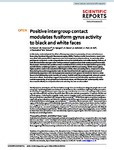Positive intergroup contact modulates fusiform gyrus activity to black and white faces
| dc.contributor.author | Farmer, H | |
| dc.contributor.author | Hewstone, M | |
| dc.contributor.author | Spiegler, O | |
| dc.contributor.author | Morse, H | |
| dc.contributor.author | Saifullah, A | |
| dc.contributor.author | Pan, X | |
| dc.contributor.author | Fell, B | |
| dc.contributor.author | Charlesford, JJ | |
| dc.contributor.author | Terbeck, S | |
| dc.date.accessioned | 2020-02-25T12:45:10Z | |
| dc.date.issued | 2020-12 | |
| dc.identifier.issn | 2045-2322 | |
| dc.identifier.issn | 2045-2322 | |
| dc.identifier.other | 2700 | |
| dc.identifier.uri | http://hdl.handle.net/10026.1/15403 | |
| dc.description.abstract |
<jats:title>Abstract</jats:title><jats:p>In this study, we investigated the effect of intergroup contact on processing of own- and other-race faces using functional Magnetic Resonance Imaging (fMRI). Previous studies have shown a neural own-race effect with greater BOLD response to own race compared to other race faces. In our study, white participants completed a social-categorization task and an individuation task while viewing the faces of both black and white strangers after having answered questions about their previous experiences with black people. We found that positive contact modulated BOLD activity in the right fusiform gyrus (rFG) and left inferior occipital gyrus (lIOC), regions associated with face processing. Within these regions, higher positive contact was associated with higher activity when processing black, compared to white faces during the social categorisation task. We also found that in both regions a greater amount of individuating experience with black people was associated with greater activation for black vs. white faces in the individuation task. Quantity of contact, implicit racial bias and negatively valenced contact showed no effects. Our findings suggest that positive contact and individuating experience directly modulate processing of out-group faces in the visual cortex, and illustrate that <jats:italic>contact quality</jats:italic> rather than mere familiarity is an important factor in reducing the own race face effect.</jats:p> | |
| dc.format.extent | 2700- | |
| dc.format.medium | Electronic | |
| dc.language | en | |
| dc.language.iso | en | |
| dc.publisher | Nature Research (part of Springer Nature) | |
| dc.subject | Adult | |
| dc.subject | Black or African American | |
| dc.subject | Female | |
| dc.subject | Humans | |
| dc.subject | Magnetic Resonance Imaging | |
| dc.subject | Male | |
| dc.subject | Neurosciences | |
| dc.subject | Occipital Lobe | |
| dc.subject | Pattern Recognition, Visual | |
| dc.subject | Photic Stimulation | |
| dc.subject | Racism | |
| dc.subject | Recognition, Psychology | |
| dc.subject | Temporal Lobe | |
| dc.subject | White People | |
| dc.title | Positive intergroup contact modulates fusiform gyrus activity to black and white faces | |
| dc.type | journal-article | |
| dc.type | Journal Article | |
| dc.type | Research Support, Non-U.S. Gov't | |
| plymouth.author-url | https://www.ncbi.nlm.nih.gov/pubmed/32060333 | |
| plymouth.issue | 1 | |
| plymouth.volume | 10 | |
| plymouth.publication-status | Published online | |
| plymouth.journal | Scientific Reports | |
| dc.identifier.doi | 10.1038/s41598-020-59633-9 | |
| plymouth.organisational-group | /Plymouth | |
| plymouth.organisational-group | /Plymouth/Faculty of Health | |
| plymouth.organisational-group | /Plymouth/Faculty of Health/School of Psychology | |
| plymouth.organisational-group | /Plymouth/REF 2021 Researchers by UoA | |
| plymouth.organisational-group | /Plymouth/REF 2021 Researchers by UoA/UoA04 Psychology, Psychiatry and Neuroscience | |
| plymouth.organisational-group | /Plymouth/Users by role | |
| plymouth.organisational-group | /Plymouth/Users by role/Academics | |
| dc.publisher.place | England | |
| dcterms.dateAccepted | 2020-01-29 | |
| dc.rights.embargodate | 2020-2-26 | |
| dc.identifier.eissn | 2045-2322 | |
| dc.rights.embargoperiod | Not known | |
| rioxxterms.versionofrecord | 10.1038/s41598-020-59633-9 | |
| rioxxterms.licenseref.uri | http://www.rioxx.net/licenses/all-rights-reserved | |
| rioxxterms.licenseref.startdate | 2020-12 | |
| rioxxterms.type | Journal Article/Review |


